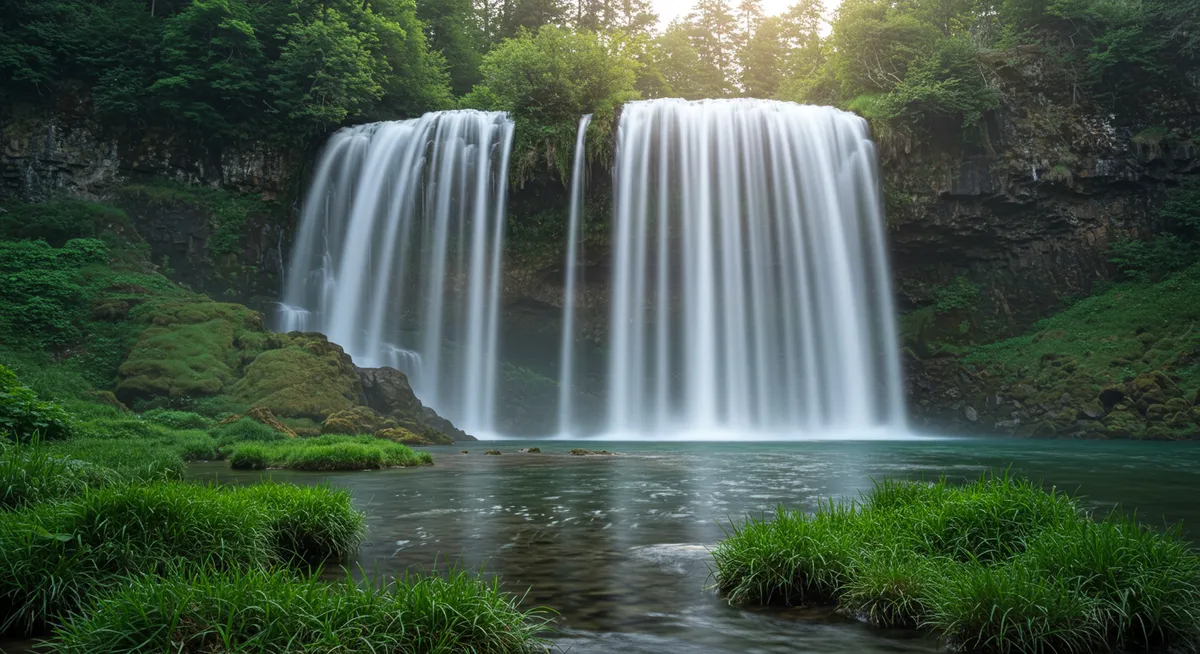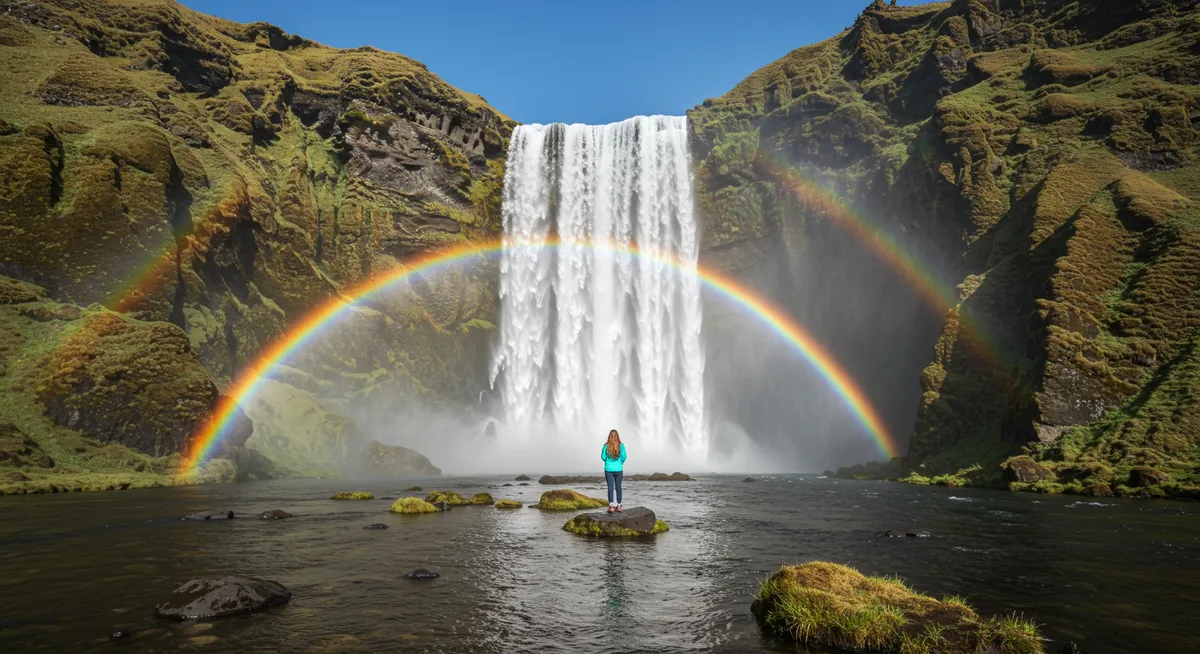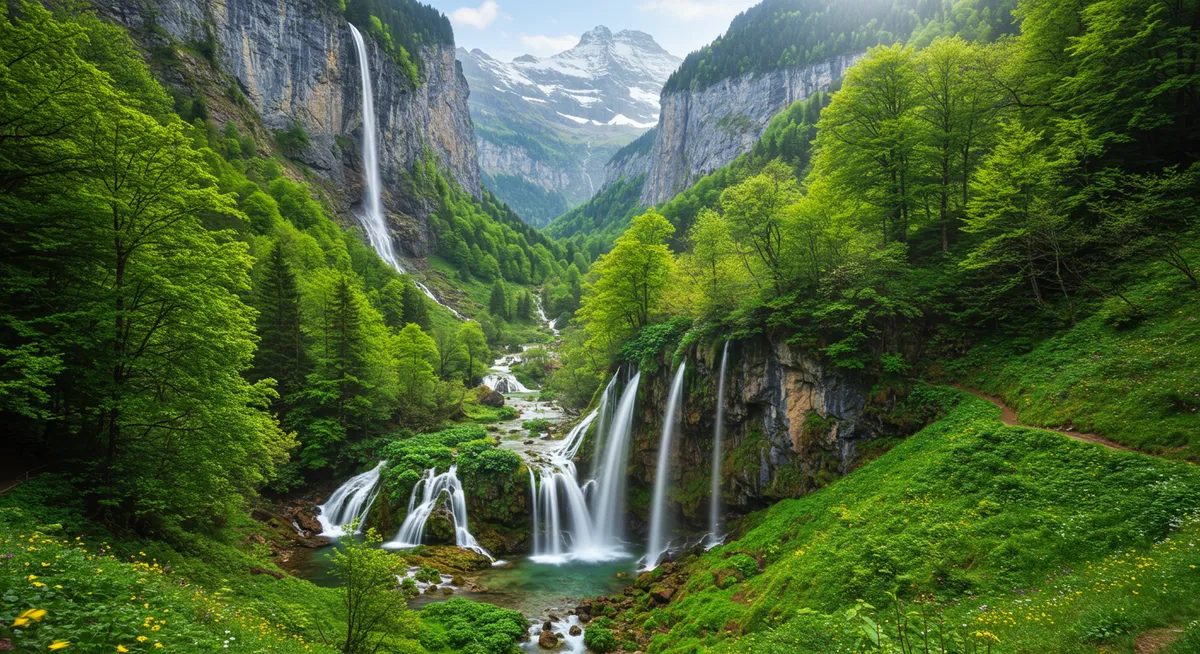Spring Waterfall Hikes at Their Most Powerful: Snowmelt Spectacles Worldwide

Spring Waterfall Hikes at Their Most Powerful: Snowmelt Spectacles Worldwide
Spring transforms waterfalls around the world into their most impressive state as winter's frozen reserves melt and flow downhill in torrents of raw power. This seasonal phenomenon turns even modest cascades into thundering spectacles and major waterfalls into awe-inspiring forces of nature. For hikers, spring creates a magical window when waterfall trails offer multisensory experiences—the visual drama of massive water volume, the thunderous roar that reverberates through canyons, and the refreshing mist that creates microclimates of lush vegetation and rainbows.

Why Spring Creates the Ultimate Waterfall Experience
While waterfalls offer year-round appeal, several factors make spring the premier season for waterfall enthusiasts:
- Maximum Water Volume: Snowmelt combines with spring rains to create peak flow conditions unmatched in other seasons
- Dramatic Transformation: Falls that might be gentle streams in summer become thundering torrents in spring
- Ephemeral Features: Some spectacular cascades exist only during the spring melt, disappearing entirely in drier months
- Lush Surroundings: The combination of moisture and warming temperatures creates explosions of greenery and flowers around waterfall basins
- Comfortable Hiking: Moderate spring temperatures make waterfall hikes more enjoyable than during summer heat
These factors combine to create a unique seasonal viewing opportunity comparable to other specialized spring phenomena like desert super blooms or European bluebell woods - all examples of nature's most dramatic seasonal transformations.
North America's Spring Waterfall Hiking Paradises
Yosemite Valley Waterfall Circuit, California, USA
Perhaps no location on earth offers a more dramatic spring waterfall transformation than Yosemite Valley. During peak snowmelt (typically April through early June), the valley becomes a symphony of falling water, with major falls reaching extraordinary volumes and dozens of ephemeral cascades appearing on the granite walls.
The Valley Loop Trail (11.5 miles full loop, though sections can be hiked independently) provides access to multiple waterfall views within a single day. Bridalveil Fall and Lower Yosemite Fall offer accessible short hikes, while the more challenging trails to Upper Yosemite Fall (7.2 miles round trip) and Vernal and Nevada Falls via the Mist Trail (7 miles round trip) reward with up-close encounters with the falls at their thundering peak.
What makes Yosemite's spring waterfalls particularly special is the combination of massive water volume and extraordinary vertical drops against sheer granite backgrounds. During peak melt, the spray from Yosemite Falls can be felt hundreds of meters away, and the appropriately named Mist Trail lives up to its reputation, soaking hikers as they climb alongside Vernal Fall.
Columbia River Gorge Waterfall Corridor, Oregon, USA
The Columbia River Gorge hosts one of North America's highest concentrations of waterfalls, with over 90 on the Oregon side alone. During spring snowmelt from the Cascade Mountains, these falls reach their spectacular peak, with many trails offering multi-waterfall experiences.
The classic 4.5-mile Multnomah-Wahkeena Falls Loop connects Oregon's highest waterfall (Multnomah at 620 feet) with five additional significant cascades through lush temperate rainforest. The trail includes both distant viewpoints and intimate paths that bring hikers close enough to feel the spray.
For a less-crowded alternative, the 7.8-mile Eagle Creek Trail passes multiple spring-charged waterfalls, including the photogenic Punchbowl Falls and the dramatic Tunnel Falls, where the path actually passes behind the roaring cascade through a tunnel blasted in the cliff face. These Pacific Northwest trails offer a fascinating contrast to the ancient woodland paths of Eastern North America, showcasing how different forest ecosystems respond to the spring awakening.
Watkins Glen Gorge Trail, New York, USA
The eastern United States offers its own spring waterfall spectacles, with Watkins Glen State Park in New York's Finger Lakes region hosting one of the most unique waterfall hiking experiences. The 1.5-mile Gorge Trail passes 19 waterfalls within a narrow, sculptured gorge that appears almost artificially designed in its perfection.
During spring, the combined snowmelt and rainfall creates maximum flow through this narrow chasm, with several falls reaching across the entire width of the gorge. The stone pathways, carved staircases, and tunnels that compose the trail provide constantly changing perspectives on the falls.
What distinguishes Watkins Glen is the intimacy of the experience—the narrow gorge channels the sound of the water, creating an immersive acoustic environment, while the close proximity of the falls makes this more of a journey through rather than to the waterfalls.
European Spring Waterfall Hikes
Plitvice Lakes Waterfall Network, Croatia
Croatia's Plitvice Lakes National Park offers perhaps Europe's most extensive waterfall network, with over 90 cascades connecting 16 terraced lakes. The park's wooden walkways create a 11-mile trail system that allows visitors to walk directly above, alongside, and sometimes behind these interconnected falls.
Spring brings extraordinary water volumes rushing over the distinctive travertine barriers that form the falls, with the increased flow turning areas that might be gentle trickles in summer into roaring cascades. The phenomenon peaks in April and May after the mountain snowmelt reaches the lakes system.
What makes Plitvice particularly special in spring is the color contrast—the mineral-rich waters appear an intense turquoise blue against the vibrant new green foliage and white limestone, creating scenes that almost appear surreal in their beauty.
Rhine Falls and Swiss Waterfall Trail, Switzerland
As Alpine snowmelt accelerates in spring, Switzerland's waterfalls reach their magnificent peak. The iconic Rhine Falls—Europe's largest waterfall by volume—transforms from impressive to truly awe-inspiring as spring meltwater increases its flow to over 600,000 liters per second in May and June.
Beyond this famous site, the lesser-known 5-kilometer Waterfall Trail in Lauterbrunnen Valley passes 10 major falls within the "Valley of 72 Waterfalls." The most spectacular is Staubbach Falls, which plunges nearly 1,000 feet from an overhanging rock face, creating such fine spray in spring that its name literally means "dust creek."
What distinguishes these Swiss waterfall experiences is the combination of Alpine grandeur and accessibility—well-maintained paths allow hikers to experience falls that in other mountain environments might require technical mountaineering skills to reach.

Rjúkandi and Iceland's Spring Waterfall Route
Iceland deserves its reputation as the "Land of Fire and Ice," but spring reveals it's equally a land of water as the island's massive ice fields begin their annual melt. While famous falls like Gullfoss and Skógafoss impress year-round, spring unlocks ephemeral falls that exist only during peak melt.
The 14-kilometer Highland Road Waterfall Hike near Egilsstaðir in eastern Iceland passes seven significant waterfalls that reach their peak flow in late May and June, including the massive multi-step Rjúkandi Falls. Unlike busier tourist areas, this trail offers solitude even during peak season.
What makes Iceland's spring waterfalls unique is their geological context—many cascade over volcanic basalt columns that create geometric patterns in the water flow, while others emerge directly from underneath glacial tongues, carrying sediment that colors the water milky blue.
Asia's Magnificent Spring Cascades
Jiuzhaigou Valley Waterfall Circuit, China
China's Jiuzhaigou National Park in Sichuan Province hosts some of Asia's most spectacular waterfall systems, which reach their peak volume when spring arrives in this mountainous region (typically April through early June).
The park's extensive boardwalk system creates approximately 9 miles of waterfall-focused trails, with the Pearl Shoal Waterfall section being particularly impressive during spring melt. Here, the wide cascade spreads across a broad limestone shelf before dropping into turquoise pools below. Nearby Nuorilang Waterfall, the widest in the park, transforms from a modest cascade to a thundering wall of water.
What distinguishes Jiuzhaigou's waterfalls is their mineral content—calcium carbonate deposits create travertine formations that give the cascades distinctive shapes and terraces, while also contributing to the extraordinary blue-green colors of the pools they pour into.
Nachi Falls Pilgrimage Trail, Japan
Japan's highest single-drop waterfall, Nachi Falls on the Kumano Kodo pilgrimage route, reaches its most dramatic state during spring. The ancient 4-kilometer pilgrimage path to the falls passes through sacred forests where spring brings cherry blossoms and new maple foliage that frame the 133-meter cascade.
What makes this spring waterfall experience culturally unique is its spiritual significance—the falls have been worshipped for over 1,300 years as a Shinto deity. The vermilion Seiganto-ji pagoda standing near the falls creates one of Japan's most iconic natural-cultural vistas, particularly beautiful when snowmelt maximizes the waterfall's power. Visitors timing their trip carefully in April may be able to combine this experience with Japan's famous cherry blossom walks for a comprehensive spring nature itinerary.
Oceania's Hidden Waterfall Gems
Milford Track Great Walks Waterfall Day, New Zealand
New Zealand's famous Milford Track passes through what has been called "the land of a thousand waterfalls" in Fiordland National Park. While strictly regulated as a multi-day hike most of the year, day access to sections with the most spectacular falls becomes possible in late spring (November in the Southern Hemisphere).
The trail's most dramatic waterfall section occurs along Arthur River, where hikers pass the 580-foot Mackay Falls and the enchanting Giant's Gate Falls. Spring brings extraordinary volumes through these systems as the Southern Alps shed their winter snowpack.
What makes New Zealand's spring waterfall experiences remarkable is their pristine nature—many cascade through untouched rainforest that has never been logged, with endemic plant species creating unique ecosystems in the spray zones around major falls.
Timing Spring Waterfall Hikes for Maximum Impact
Snowpack Monitoring for Optimal Timing
The precise timing of peak spring waterfall flow varies annually based on winter snowpack depth and spring temperature patterns. For serious waterfall enthusiasts, monitoring these factors can optimize the experience:
- Snowpack Reports: Government agencies in many countries publish regular snowpack measurements as percentage of normal
- Temperature Tracking: Sudden warm spells accelerate snowmelt, creating dramatic but shorter peak flow periods
- Rainfall Patterns: Spring rains combined with snowmelt can create particularly spectacular conditions
Generally, lower-elevation waterfalls reach peak flow first, with successively higher falls reaching their maximum later in spring. This creates opportunities for extended waterfall seasons by starting in lowland areas and progressively moving to higher elevations.
Regional Timing Guidelines
While specific timing varies annually, these general guidelines help plan spring waterfall hikes by region:
- U.S. Sierra Nevada (including Yosemite): Mid-April through early June, with peak typically in May
- U.S. Pacific Northwest: March through early May
- U.S. Northeast: Late March through April
- European Alps: May through mid-June, with higher elevations peaking later
- Iceland: Late May through June
- Japan: March through April, coinciding with cherry blossom season in many areas
- New Zealand: October through early December (Southern Hemisphere spring)
Many park services now offer "waterfall condition reports" during spring, similar to fall foliage reports, helping visitors time their trips to coincide with peak flow conditions.
Photography Tips for Spring Waterfalls
Spring waterfalls present both extraordinary photographic opportunities and technical challenges. The high water volume creates dramatic scenes but also generates significant spray that can damage equipment and obscure lenses.
For the classic "silky water" effect, bring a tripod and neutral density filters that allow longer exposures even in daylight conditions. Experiment with various shutter speeds—while many photographers default to very long exposures, moderate speeds (1/15 to 1/4 second) often better capture the dynamic energy of powerful spring cascades while still conveying motion.
Protect your equipment with rain covers, lens hoods, and microfiber cloths to quickly dry spray from lenses between shots. For popular waterfalls, arrive very early both for softer morning light and to photograph before other visitors appear in your compositions.
Consider including people for scale in at least some images—the immense power of spring waterfalls often doesn't translate in photographs without reference objects that convey their true size and force.
Safety Considerations for Spring Waterfall Hikes
Unique Spring Hazards
While extraordinarily beautiful, spring waterfall hikes present specific safety challenges not present during other seasons:
- Slippery Conditions: Increased spray creates extremely slippery surfaces on rocks and trails near falls
- Higher Water Crossings: Streams that might be easy to cross in summer can become dangerous in spring
- Undercut Banks: High water can erode soil underneath seemingly solid stream edges
- Cold Water Danger: Spring meltwater remains dangerously cold, causing rapid hypothermia if hikers fall in
- Flash Flood Risk: Spring storms combined with snowmelt can cause rapid water level changes
Essential Precautions
Safely enjoying spring waterfall hikes requires specific preparations:
- Wear appropriate footwear with aggressive tread patterns designed for wet conditions
- Carry trekking poles for additional stability on slippery surfaces
- Stay on designated trails and viewing platforms, particularly at popular falls
- Never climb on rocks adjacent to waterfalls, as these are typically smoothed by water action and extremely slippery
- Check weather forecasts for watershed areas above your hike, not just your immediate location
- Carry extra layers—the temperature near powerful spring waterfalls can be significantly colder than surrounding areas due to evaporative cooling
Conservation and Waterfall Ethics
Popular waterfall destinations face increasing pressure from visitors, particularly during peak spring conditions when social media draws crowds seeking dramatic photos. Practice responsible waterfall ethics to preserve these special places:
- Respect closures and barriers—they protect both visitors and sensitive waterfall ecosystems
- Never add or remove rocks from waterfall streams, as this alters natural flow patterns
- Stick to designated viewpoints rather than creating "social trails" that cause erosion
- Consider visiting lesser-known waterfalls to reduce pressure on famous sites
- Never use soap or shampoo in waterfall pools, even "biodegradable" products
- Pack out all trash, including organic matter like fruit peels that don't belong in these ecosystems
Beyond the Famous Falls: Finding Solitude
While iconic waterfalls like Yosemite Falls and Rhine Falls deservedly attract attention, spring creates opportunities to discover spectacular seasonal cascades that receive far fewer visitors. Resources like local hiking clubs, ranger-led programs, and specialized guidebooks often highlight seasonal waterfall hikes that don't appear prominently in general tourist information.
Consider exploring national forest lands adjacent to popular national parks, where waterfalls often receive a fraction of the visitation despite similar natural beauty. Watershed maps combined with topographic information can help identify promising streams with significant elevation changes that likely harbor undocumented cascades during spring melt.
For genuinely solitary experiences, focus on waterfalls that require longer hikes (5+ miles), as visitor numbers typically decrease dramatically with distance from trailheads, even during peak spring conditions.
Wildlife Encounters Along Spring Waterfall Trails
Spring waterfall corridors create unique wildlife viewing opportunities as animals are drawn to these water sources after winter. The cool, moist microclimate around powerful falls supports distinctive plant communities that attract diverse wildlife, often concentrated in these corridors before broader spring greening occurs elsewhere.
In North American waterfall zones, look for amphibians breeding in calm pools near falls, migratory birds following waterways, and mammals like deer and bears visiting to drink and feed on fresh vegetation. European Alpine waterfall trails often provide opportunities to spot chamois and ibex as they descend to lower elevations following the spring melt line.
The combination of moving water sounds and concentrated visitor traffic on designated trails actually increases wildlife viewing chances, as animals become habituated to these predictable human patterns and remain visible while maintaining safe distances. Bird watchers may want to combine waterfall visits with dedicated spring bird migration walks for a comprehensive spring wildlife experience.

Cultural Connections to Powerful Waters
Many spring-charged waterfalls hold deep cultural significance to indigenous communities and local populations. In numerous traditions worldwide, the seasonal transformation of waterfalls represents important spiritual transitions, with the increased flow symbolizing purification, renewal, and life-giving power.
In Japan, spring waterfall visitation remains connected to ancient Shinto traditions celebrating the kami (spirits) believed to reside in particularly powerful cascades. Native American tribes across North America have long held ceremonies timed with the spring transformation of significant waterfalls, some of which continue today.
Learning about these cultural dimensions adds depth to spring waterfall experiences. Many parks now incorporate indigenous perspectives into interpretive materials, while guided programs may include cultural history alongside natural information.
Accessible Spring Waterfall Experiences
The dramatic nature of many waterfall trails can present challenges for visitors with mobility limitations, but numerous spectacular spring cascades offer accessible viewing options. Many major waterfall destinations have invested in creating viewpoints and even partial trails that meet accessibility standards while still providing immersive experiences.
In Yosemite, the Lower Yosemite Fall trail offers wheelchair-accessible paths to experience the fall at its spring peak. The Columbia River Gorge features several roadside viewpoints with accessible platforms for enjoying spring-charged falls without hiking. Throughout Europe, many spectacular Alpine cascades have developed viewing infrastructure accessible to all ability levels.
For visitors who can handle moderate terrain but not longer hikes, focusing on waterfalls with short access trails allows experiencing the spring phenomenon without covering extensive distances—another advantage of researching lesser-known falls that often have parking areas closer to the cascades themselves.
Explore More Spring Nature Wonders
Spring waterfalls represent just one of the season's spectacular natural transformations.
Discover other breathtaking seasonal phenomena in our guide to Spring Nature Walks Around the World.